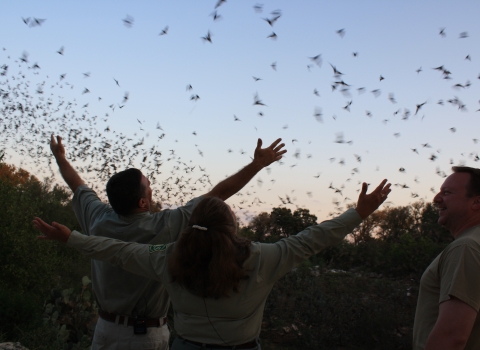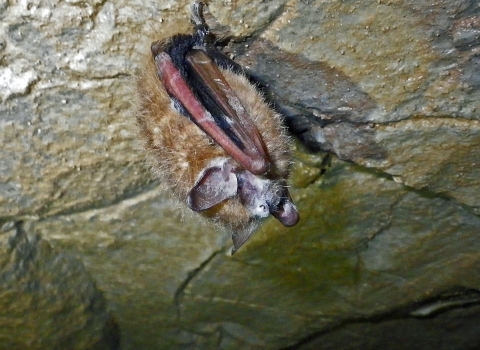The Yakama Nation is on a mission to find bats on their lands. And the U.S. Fish and Wildlife Service is supporting the effort.
It isn’t easy. Finding bats in the open shrub-steppe of south-central Washington requires some knowledge of where to start. Fortunately, Mark Nuetzmann has been their wildlife biologist for more than 20 years and knows his Pacific-Northwest bats.
All native animals and plants are important to the Yakama people, and central to their religion, culture and heritage. (The word for bat in the Ichishkiin language is ‘lach'at lach'át’.) Nuetzmann divides his time between studying animals the Yakama traditionally harvest, like salmon; evaluating northern spotted owl habitat in support of the Nation’s timber harvest; and evaluating the area’s bat populations.
He loves his job and appreciates the diversity of the habitats he works on. “Bat work has taken me out to other parts of the reservation,” he said. “We have so much habitat that’s beautiful.”
Yakama Landscape and Bat Habitat
This is a land of ponderosa pine, Oregon white oak and rangeland for the Nation’s grazing animals. Habitat shifts to more dense mixed-conifer and true-fir forests as elevation and moisture increase, ultimately reaching the peak of Mt. Adams at 12,281 feet. With so many landscapes, Nuetzmann notes that most of the known bat habitat types found in Washington are represented here.
Finding the bats is important work. White-nose syndrome was first recorded in Washington in 2016, and while the fungus that causes white-nose syndrome- was found in Yakama County in 2021, the disease hasn’t reached Yakama Tribal lands yet.
Much of what bat experts know about their habitat and where they migrate differs between the western and eastern U.S. Bats have been known to roost in a variety of locations, including under bridges, between cracks in mountainous-area rock walls, and even in trees, but Nuetzmann’s work will focus on surveying the reservation’s older buildings and open areas where bats fly.
Based upon his earlier observations, Nuetzmann suspects they’re using the buildings as day roosts. Additionally, it’s possible the buildings serve as hibernation areas and maternity colonies during the winter. “They can get into tight nooks and crannies in these old buildings where it’s difficult to shine a light,” he said.
One year, Nuetzmann caught a lactating Townsend’s big-eared bat, so he suspects a maternity colony is nearby. Part of his work will include emergence surveys to tally how many bats — and which species — leave these structures at night to feed.
New Efforts to Find Bats
In 2021, to meet the growing need for white-nose syndrome monitoring, the Nation applied for funding through the U.S. Fish and Wildlife Service’s White-nose Syndrome Grants to States and Tribes program to assess bat populations and determine future research needs across the reservation. Bats in Washington known to have the disease include the little brown, Yuma, western long-eared, and fringed myotis. Additionally, silver-haired bats have been found with the fungus on them but no signs of disease.
Thanks to the Service funding, Nuetzmann was able to integrate a new technology — autonomous recording units — into his bat surveys. The devices sit on poles across the reservation, in meadows and shrub-steppe landscapes and in front of old buildings, recording the bats’ calls as they fly by. He then downloads that data and uses software to identify bat species.
Using data from previous years as reference, Nuetzmann says it’s possible he will find up to 14 bat species. The current work started in summer 2022, and he is currently surveying eight areas across different habitats using the the North American Bat Monitoring Program protocol.
White-Nose Syndrome
The goal is to help the Yakama Nation stay ahead of the white-nose syndrome fungus by monitoring bats and preventing its spread across their lands. The Yakama Nation is partnering with the Washington Department of Fish and Wildlife to analyze bat guano for the presence of the fungus. Nuetzmann will collect the feces at buildings used by bats on the reservation.
Bat awareness is important in these efforts. Nuetzmann works with people living in the reservation’s valley to carefully exclude bats from their homes. He is most worried about rabies, but, “It’s important to minimize contact where bats are congregating, whether it’s a cave, or other places where we can transfer the fungus to other colonies and bats.” He adds, “we don’t have a lot of caves.” Thus, the need to find bats in new and old buildings.
To keep the fight against white-nose syndrome alive in coming years, Nuetzmann wants to get the word out. He assists with a camp that aims to teach high school students about bats, rabies, and white-nose syndrome, and ultimately, spark their interest in wildlife, conservation work, biology and science. The biologists capture the bats, and the students see the bats in action. “Most people don’t get a chance to see bats up close; they love that.”
Perhaps one day, when Nuetzmann has moved on, one of those students will continue his stewardship of the Yakama Nation’s wildlife in this diverse and beautiful landscape.
---
For more information about the Yakama Nation, please visit their web site.








